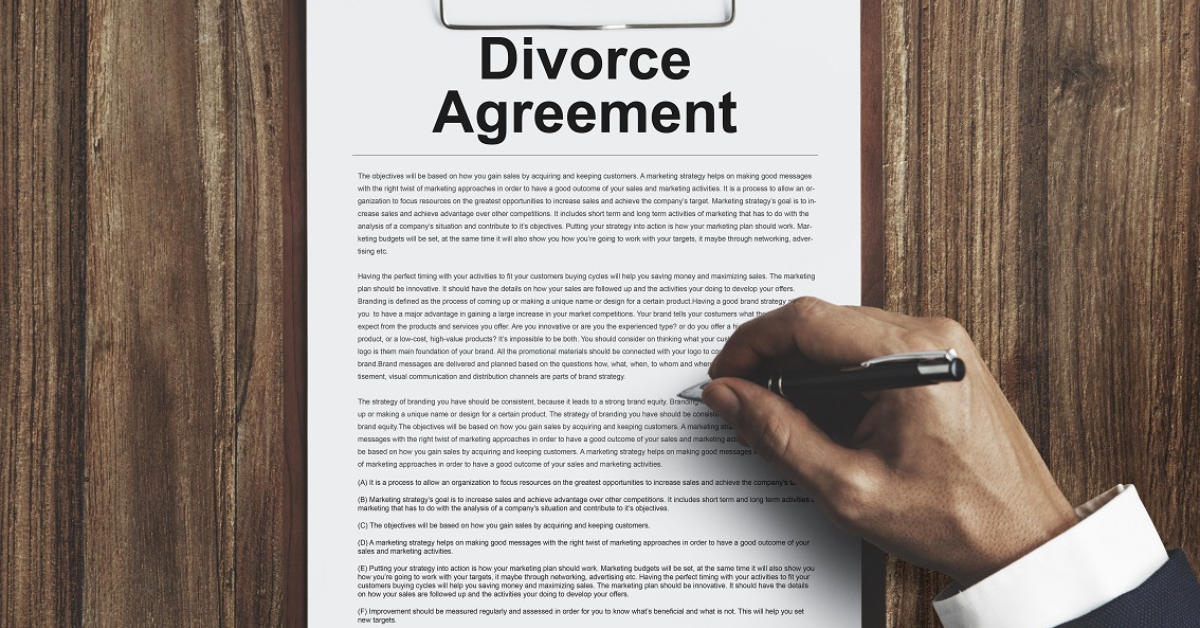Navigating the complexities of drafting a divorce agreement can be a daunting task, but with the right guidance, you can ensure a smoother process and a more favorable outcome. As a Dating Guru, you know that clear communication and understanding are key in any relationship, including the legal aspects of a divorce. Crafting an effective divorce agreement requires attention to detail and a strategic approach to address all pertinent issues.
In this article, I’ll share essential tips and tricks to help you draft a divorce agreement that meets your needs and protects your interests. From outlining custody arrangements to dividing assets and liabilities, each step plays a crucial role in shaping the agreement. By leveraging these expert insights, you can navigate the negotiation process with confidence and clarity, paving the way for a more amicable and efficient resolution.
Understanding the Importance of a Divorce Agreement

When discussing the importance of a divorce agreement, it’s crucial to recognize why this legal document holds significant weight in the process of ending a marriage. Your divorce agreement essentially serves as the blueprint for your post-marriage life. It outlines essential details such as financial responsibilities, child custody arrangements, and asset division, providing a clear roadmap for both parties moving forward.
- Protecting Your Interests
- A well-crafted divorce agreement safeguards your interests by clearly defining the terms of your separation. This includes outlining who gets what assets, determining child support and alimony obligations, and establishing visitation schedules. By formalizing these agreements, you minimize potential misunderstandings and conflicts in the future.
- Legal Clarity and Certainty
- Your divorce agreement serves as a legally binding document that ensures all parties involved are aware of their responsibilities and rights. It provides a structured framework for addressing any disputes that may arise post-divorce, offering a sense of security and predictability during an emotionally challenging time.
- Ensuring Fairness
- With a detailed divorce agreement in place, both you and your ex-spouse have a clear understanding of what is expected of each party. This transparency fosters a sense of fairness in the division of assets and allocation of responsibilities, promoting a more amicable and equitable resolution.
- Facilitating Communication
- Crafting a divorce agreement requires open communication and negotiation between both parties. This process encourages you and your spouse to articulate your needs and concerns, fostering a cooperative approach to resolving key issues. By actively engaging in these discussions, you lay the groundwork for a more respectful and collaborative post-divorce relationship.
In essence, your divorce agreement acts as a crucial tool for establishing order, clarity, and fairness in the process of dissolving your marriage. By acknowledging its significance and investing the time and effort to create a comprehensive agreement, you set the stage for a smoother transition into your new life chapter.
Planning the Key Components of a Divorce Agreement

When planning a divorce agreement, it’s crucial to pay attention to specific components that will shape the terms of your separation. Here are some essential considerations to keep in mind as you navigate this process:
Determining Custody Arrangements
When determining custody arrangements, you and your ex-spouse must establish clear guidelines for the care and upbringing of your children. This includes outlining where the children will reside, visitation schedules, and decision-making responsibilities regarding their well-being. By establishing a comprehensive custody agreement, you can ensure that both parents’ rights and obligations are clearly defined, fostering stability and routine for your children during this transition.
Outlining Financial Agreements
Creating detailed financial agreements is paramount in a divorce settlement. This involves outlining how assets and liabilities will be divided, determining alimony or spousal support, and establishing child support payments if applicable. By clearly defining these financial arrangements, you can mitigate potential disputes and ensure that both parties understand their financial responsibilities post-divorce. Additionally, outlining financial agreements in the divorce agreement provides a clear roadmap for the financial aspects of your separation, promoting a smoother transition into your new individual financial circumstances.
Planning these key components meticulously is essential for crafting a comprehensive divorce agreement that safeguards the interests of all parties involved. By addressing custody arrangements and financial agreements thoughtfully, you can navigate the divorce process with clarity and ensure a more amicable and efficient resolution.
Drafting and Structuring the Divorce Agreement

When drafting your divorce agreement, clarity and precision are crucial. This document acts as a roadmap for your future, detailing crucial aspects like financial obligations, child custody arrangements, and asset distribution. By following these structured tips, you can ensure that your divorce agreement serves its purpose effectively.
Establishing Clear Guidelines
- Define Custody Arrangements: Outline specifics related to child care, residency, visitation schedules, and decision-making responsibilities. This clarity provides stability for your children during this transitional period.
- Structuring Financial Agreements: Cover important financial aspects like dividing assets, determining alimony, and establishing child support. Clearly outlining these agreements minimizes potential disputes and ensures financial responsibilities post-divorce are well-defined.
Ensuring Legal Clarity
- Define Terms Clearly: Use precise language to articulate rights and responsibilities. This minimizes misunderstandings and provides a legal foundation for both parties.
- Foster Fairness and Transparency: By clearly defining asset division and obligations, you promote a sense of fairness and transparency in the negotiation process. This clarity benefits both parties involved.
- Open Dialogue: The process of crafting a divorce agreement encourages open communication. This sets the tone for a respectful post-divorce relationship, fostering cooperation and understanding.
- Negotiate Thoughtfully: Approach negotiations with a focus on reaching mutually beneficial agreements. Consider the needs and concerns of both parties to create a balanced and satisfactory outcome.
By structuring your divorce agreement thoughtfully and with attention to detail, you can navigate the complexities of divorce proceedings with clarity and confidence. Following these guidelines ensures that your agreement serves its purpose effectively, setting the stage for a smoother transition into your post-marriage life.
Read more: Rebuilding Your Life and Finding New Love After Divorce
Ensuring Legal Compliance and Clarity

When creating your divorce agreement, it’s crucial to ensure legal compliance and clarity to avoid future conflicts and uncertainties. Here are essential tips to help you navigate this aspect effectively:
Emphasize Specificity in Terms
Ensure that the terms in your divorce agreement are specific and leave no room for ambiguity. Define details such as custody arrangements, visitation schedules, child support amounts, alimony terms, and asset division with precision. Specificity in these terms can help prevent misunderstandings and legal disputes in the future.
Seek Legal Advice
Consulting with a legal professional specializing in family law can provide you with valuable insights and ensure that your agreement complies with legal requirements. A family law attorney can help you understand your rights, obligations, and options, guiding you through the process to create a legally sound agreement that protects your interests.
Use Clear and Understandable Language
Choosing clear and understandable language in your divorce agreement is essential to ensure that both parties comprehend the terms thoroughly. Avoid legal jargon or overly complex language that may lead to misinterpretation. By using straightforward language, you can promote clarity and mutual understanding, reducing the likelihood of disagreements.
Address Future Contingencies
Anticipating and addressing potential future contingencies in your agreement can help you navigate unexpected circumstances without revisiting the agreement. Consider including provisions for scenarios like job loss, relocation, changes in income, or modifications to custody arrangements. By proactively addressing these contingencies, you can maintain the stability and effectiveness of the agreement over time.
Review and Update Regularly
Regularly reviewing and updating your divorce agreement, especially when significant life events occur, is essential to ensure its continued relevance and effectiveness. Whether it’s a change in financial circumstances, living arrangements, or children’s needs, staying proactive in reviewing and updating the agreement can help you address evolving needs and maintain its legal compliance.
By following these tips and ensuring legal compliance and clarity in your divorce agreement, you can establish a solid foundation for post-divorce life, protect your interests, and promote a smoother transition into a new chapter. Remember, investing time and effort in creating a comprehensive and legally sound agreement can lead to a more amicable resolution and a clearer path forward.
Conclusion
Crafting an effective divorce agreement is a crucial step towards ensuring a smoother transition into post-marriage life. By following expert tips and strategies outlined in this article, you can navigate the negotiation process with confidence. Clear communication, precise language, and a focus on key components like custody arrangements and financial agreements are essential for creating a comprehensive and fair agreement. Remember, investing time and effort into drafting a well-structured divorce agreement not only protects your interests but also fosters transparency and fairness between both parties. Prioritize legal compliance, seek professional advice when needed, and regularly review and update the agreement to maintain its relevance. With a carefully crafted divorce agreement in place, you can pave the way for a respectful post-divorce relationship and a successful transition into a new chapter of your life.
Frequently Asked Questions
What are the key components to consider when drafting a divorce agreement?
When drafting a divorce agreement, key components to consider include custody arrangements, financial agreements (asset division, alimony, child support), and legal compliance for clarity and effectiveness. By outlining these aspects clearly, you can mitigate disputes, protect interests, and ensure a smoother transition post-divorce.
Why is open communication important when creating a divorce agreement?
Open communication is crucial when creating a divorce agreement as it fosters understanding, minimizes misunderstandings, and allows for negotiation and compromise. Clear communication helps define terms, rights, and responsibilities, promoting fairness, transparency, and a respectful post-divorce relationship.
How can a well-crafted divorce agreement benefit individuals?
A well-crafted divorce agreement serves as a blueprint for post-marriage life, protecting individual interests by defining terms, minimizing misunderstandings, and providing legal clarity. It ensures awareness of rights and responsibilities, fostering fairness in asset division and obligations while promoting a smoother transition into a new life chapter.

